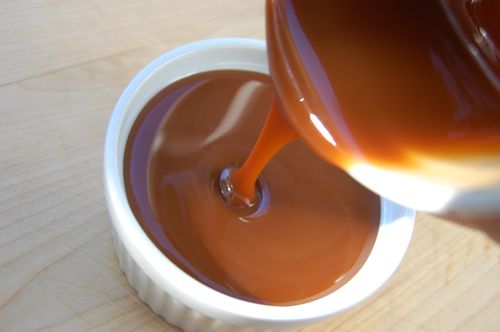Caramelization or Maillard Reaction?
I don’t think anyone can say for certain. In a nutshell, caramelized white chocolate is produced by heating white chocolate to around 260 degrees Fahrenheit and leaving it there for roughly 45 minutes, until it turns a pale shade of brown. But that’s easy, you might say, it’s a proven fact that caramelization of sugar doesn’t happen until sugar approaches 300 degrees Fahrenheit. The browning in the white chocolate must be a result of Maillard reactions — protein browning — which can occur below 300.
To that I would say: maybe yes, maybe no. For the fact is some fairly startling scientific work has been done on the subject caramelization in the last two or three years. Case in point a 2012 University of Illinois study by a chemist named Shelly Schmidt. She discovered that caramelization can indeed happen at a much lower temperature. More than that she discovered that sugar can caramelize before it even melts. It was a fairly stunning revelation, one which has been summarized by Harold McGee here. Essentially the idea is that while caramelization occurs only at a high temperature when you prepare it quickly in a pan, the same type of molecular breakdown can happen at a low temperature if the heat is sustained for a long period of time. Neato.
Now me, I suspect that both caramelization and Maillard reactions are occurring when white chocolate is slowly baked. I’m not a chemist so I have no proof of this, just a hunch. I’ve often marveled at the way dulce de leche browns as it’s boiled. The conventional wisdom has always been that the browning is the result of milk protein breakdown (Maillard browning) because caramelization can’t occur at the boiling point. But dulce de leche has unmistakable caramel notes in it, not to mentioned a very deep brown color. Milk is only 3.2% protein. Can such a small amount of browned milk protein really do all that? I mean, have a look at this dulce de leche right here:

Granted it’s reduced, but still it seems rather unlikely to me. My feeling is that there’s sugar caramelization going on in addition to Maillard browning. I suspect something similar is happening with caramelized white chocolate. Of course I can’t say for certain, maybe some day Shelly Schmidt will weigh in with an answer!
Joe
…didn’t expect the finished product to be this liquified… well, I didn’t know what to expect, maybe sort of fudge-like perhaps! …delicious!
Hey Susan!
That’s actually dulce de leche…I should have been a little more clear in the post. I’ll go back and make some tweaks! Thanks for the heads up!
– Joe
Anyone who has studied thermodynamics and reaction kinetics will tell you that a chemical reaction is not a cut and dry thing. For example, diamond will turn to carbon dioxide at room temperature but at a rate that’s not perceptible. Carmelization may not happen favorably at that temperature, but that does not mean it is not happening; it just means that its reverse reaction is happening at an equal or greater rate to keep it in check.
Great stuff, Chemist, for it did seem so cut and dried back in school! I thank you.
– Joe
My guess – and I’m an engineer, not a chemist (and not even a chemical engineer, at that) – is that as long as you have enough heat *transferred* to the sugar, you’ll get some caramelisation. At a lower temperature, it will take longer to transfer enough energy into the sugar to make the reaction happen, but it’s still possible.
That’s what I’ve been learning, Jane. I had no idea there were shades of grey with chemical reactions. Most of my life I thought they either happened or they didn’t…not “sort of” or in slow motion. That’s one reason I love blogging…I’m constantly learning from people who actually know what they’re doing in life!
Cheers,
– Joe